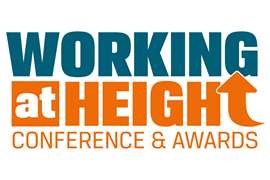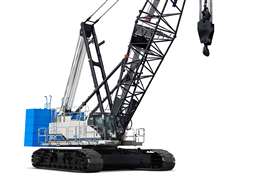Heavy lifting on site
23 January 2014

All over the world, new build reactor houses, nuclear plants, oil and gas projects and power stations are undergoing extensive development. This has increased the need for heavy lift cranes to work in these areas, as a spokesperson from Japanese specialist contractor Uchimiya explains, “After the Great East Japan Earthquake in 2011, reconstruction demand increased. Moreover, Japanese power companies strengthened the ability of thermal power plants, instead of nuclear power plants. In the future, we expect the increase of demand for construction, thanks to construction projects related to the Tokyo Olympics in 2020.”
As a result of this global growth, many end users of heavy lift cranes are experiencing strong resale markets and longer rental periods. Rick Mikut, crawler crane manager of All Erection & Crane Rental Corp in the USA, explains, “We are seeing a strong resale market, both domestic and international. Another shift we’re seeing is longer rental periods. A crane can be tied up for two to three years, whereas previously there was more movement between jobs. Shorter rental periods were more common in the recent past.”
Other shifts in the industry include the change in the design and layout of the job site, which this is having a direct impact on crane manufacturers and rental companies working in these areas. Keith Rind, vice president of Buckner HeavyLift Cranes, explains, “We are seeing tighter, more challenging sites, tighter safety restrictions, more demanding customers and continuing pressure on rates. There are also significant requirements for reduced ground bearing pressures and increased demand for heavy lift attachments.”
Mikut agrees, “We seem to have less and less room on most job sites. This often means lifting at a wider radius since we have to position ourselves further away from the target. In other words, cranes have to sit further back from the lifting area, whereas previously they could sit in closer. The greater the distance the crane has to sit from the actual lift site, the stronger it has to be.”
Kate Lampson from heavy lift provider Lampson International, explains, “To overcome confined spaces at refineries, heavy lift cranes need a small footprint. The latest model in our fleet is the Lampson Transi-Lift LTL-3000. This crane has a 121 metre main boom, 36.5 m jib and a 6 m jiblet. In addition, it has hydraulic hoists, a larger boom cross section and the wire rope has been increased from 1 ½ to 2 inches [38 to 51 mm].
“Our second largest capacity crawler crane is our Lampson Transi-Lift LTL-2600. We most recently used this Transi-Lift model with 103 m main boom and a 60.9 m jib with a pick radius of 206 tonnes at 128 m during the expansion of a manufacturing facility in the Pacific Northwest.”
This need for increased crane capacity isn’t just limited to end users faced with smaller working environments; it’s also a requirement for cranes required to handle the new wave of single piece components. Heavy lift and transport company, Fagioli, headquartered in Italy, explains the issue, “The modularisation of components has boomed during the last few years, pushing contractors and clients to build bigger and bigger modules. This caused a number of problems for companies in charge of moving, lifting or installing the pieces, as single pieces could weigh thousands of tonnes. This is becoming a kind of standard, especially in petrochemical sectors, offshore platforms and drilling rig towers.”
As suggested by Jerry Maloney, Manitowoc Cranes global product director, the trend for ever larger components is being driven by a number of factors, including shrinking job site schedules. “Many petrochemical or energy-related facilities need upgrading to contend with increased demand for their product,” Maloney says. “As a result, up-and-over lifts are growing, and we are seeing more and more cranes performing lifts with bigger radii as they lift huge loads over existing structures.”
This problem isn’t just limited to certain areas, the situation is occurring all over the globe. In Japan, for example, crane rental company Uchimiya has to contend not only with strict time restrictions, small construction sites with narrow roads, but weight, height and width restrictions, which can be a tremendous challenge. “One of our biggest challenges was the installation of a power reactor at a petroleum plant in Tohoku area, Japan” a company spokesperson tells IC. “The reactor weighed 1,190 tonnes and was 40 m tall. To complete this difficult task we had to use three crawler cranes simultaneously; two Kobelco SL13000s with a lifting capacity of 800 tonnes and a Kobelco 7800 with a lifting capacity of 750 tonnes.”
Other challenges associated with heavy lifts include transportation issues, as Mikut points out, “The biggest challenges with heavy lifts involve equipment transport. Planning a load sequence is very difficult; all the equipment parts have to be in order so that building and installation goes as smoothly and as quickly as possible. This demands a tremendous degree of foresight. Furthermore, there has to be enough room on-site, let alone advance ground preparation, so that we’re able to perform the lift in question. However, because preplanning for many lifts is done months prior to the actual lift the parameters are constantly changing.”
Working giants
The change in component dynamics and the space in which a crane is required to perform a lift has resulted in equipment becoming ever more project-related. “For us this means we have to plan and provide equipment that is more and more short-term,” a spokesperson from Liebherr Werk Ehingen explains.
“Customers want the best lifting charts at immense heights and reach,” Maloney adds, “They also want easy operation, easy mobilisation and reduced set-up costs and less transport cost. On top of all that are the standard safety concerns. So, the challenges we face are everywhere and, as lifts get bigger and demands higher, the challenges we must overcome are ever-increasing.”
The outcome of these specific requests has been a new wave of heavy lift cranes, each one complete with a smaller footprint and an increase in capacity compared to previous models. But the route to completion hasn’t been an easy one, as Guntram Jakobs, Terex Cranes crawler cranes product manager, explains, “Designing a crane that can lift thousands of tonnes is no easy task, and designing a crane that can lift thousands of tonnes and still be easily transportable is a major challenge.”
To meet these requirements Terex offers three crane models: the CC 8800-1 and the CC 9800, both with a 1,600 tonne capacity, and the CC 8800-1 Twin with a 3,200 tonne capacity. The cranes come fitted with a fall protection system and can move whilst under load. “The CC 8800-1 can be converted into a CC 8800-1 Twin with an addition of a Twin kit,” Jakobs adds, “This is because a customer might not always have a lift planned for a super heavy lift crane, but having a 1,600 tonne base machine allows the customer to have more job possibilities and be more profitable.”
Also designed to meet space constraints on job sites are the Liebherr LR 11000 crawler crane and the LTM 1750-9.1 wheeled mobile crane, both of which are manufactured at Liebherr Werk-Ehingen. The LR 11000 has a 9.2 m track width and can be configured with an S-type main boom and a W-type luffing jib. It can also have a PowerBoom system with a heavy luffing jib. To make transportation easier the 1,000 tonne LR 11000 has a transport width of 3.5 m and a height of 3.2 m and individual component weights can be reduced to 45 tonnes. In addition, a new boom system is available on a smaller Liebherr model, the LR 1600/2, to increase lifting capacities. Also from Liebherr is the 3,000 tonne LR 13000, which is currently the strongest crane in Liebherr’s range.
Keeping the key requirements of customers in mind, the 9-axle LTM 1750-9.1 can be driven on public roads with a complete telescopic boom. It has a lifting capacity of 750 tonnes and is designed for short setup times. “The power train for the crane superstructure, comprising the engine and the hydraulics as well as a ballast device, is transported separately to the site, mounted on the crane by the crane itself and connected using quick-release couplings,” Wolfgang Beringer, Liebherr-Werk Ehingen, adds.
The largest model from Manitowoc is the 2,300 tonne capacity model 31000 crawler crane, which has a variable position counterweight system. “The 31000’s four crawler concept was born out of the need to make shipping as easy as possible, as was the segmented carbody and the single main boom (as opposed to a twin boom),” explains Maloney. “Similarly, the VPC counterweight minimises the volume of counterweight as it automatically adjusts, balancing the rear moment needed to offset the forward moment caused by the load and radius.”
For the offshore heavy lift sector, Liebherr-Werk Nenzing has developed the TCC 14000-400, a combined offshore and mobile harbour crane with a maximum under hook height of 68 m. The crane can be fixed on a floating installation barge or used as an offshore crane under offshore conditions. “As an offshore crane it is able to lift heavy loads up to a maximum of 400 tonnes at an outreach of 21 m; at an outreach of 70 m the crane is still able to hoist 91 tonnes,” a company spokesperson explains.
In addition to this, the undercarriage of the crane has a central X-shaped structure to which four outriggers are mounted. “This allows the TCC 14000-400 D Litronic to operate onshore as a mobile harbour crane,” Tobias Froehlich, strategic marketing communications at Liebherr-Werk Nenzing adds. “This makes it ideal for customers with demand for both heavy lift cargo handling in ports and floating solutions for typical offshore applications, like the construction of oil platforms or the installation of wind power stations in the sea.”
Beating competition
Although there are jobs out there in the lifting sector (and there are plenty of them and more to come as the energy sector grows) the number of young people joining the profession is simply not meeting demand. “The combined effect of the recession and the simple fact that young adults aren’t as inclined to seek jobs in the trades, as they did a generation ago, has left many companies like ours constantly looking for new talent to help us keep growing,” Mikut says.
This problem is being felt more and more by lifting service and equipment providers and as the world continues to grow and the requirement for heavy lift equipment continues to grow with it, the need for a new generation of operators and workers has never been so important.
SKIDDING SYSTEMS
Heavy lift provider Fagioli has a number of lifting systems including strand jacks, tower lift systems and a skidding and elevator system, which gives a lifting capacity up to 7,200 tonnes (skid shoes capacity up to 1,000 tonnes each). In addition to this, Fagioli is planning an advanced modular skidding system: a push and pull self-propelled system with a load cell weighing system. “This system will provide a capacity of 64,000 tonnes and being computer controlled, will be able to simultaneously and separately check the load and its main parameters, for each single skid shoe,” a company spokesperson told IC.
Fagioli recently used a strand jack system at the MOSE project in Venice. The company used the system to install 12,000 tonne caissons and 400 tonne barriers to prevent Venice from flooding. For the project, Fagioli used a tailor made catamaran with strand jacks to drag and lower the 12,000 tonne caissons into the water. The catamaran was also used to install a launching structure to lift and lower the barriers into the water.
“Fagioli is also in the process of building a push-up system for the hoisting of topside and off-shore platforms with a capacity up to 24,000 tonnes,” a company spokesperson added. “The push-up system could be used in combination with a tower lift system.”






